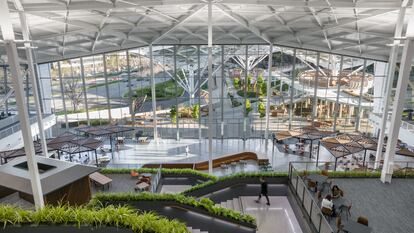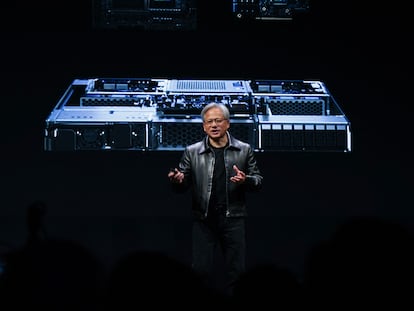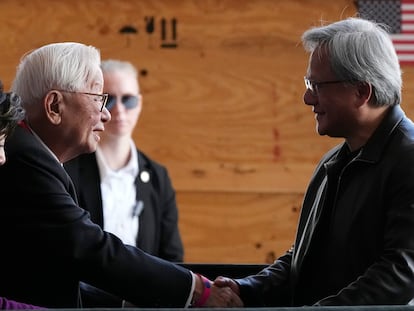Inside Nvidia’s museum of the future
The great champion of artificial intelligence — which was conceived in a fast food restaurant in 1993 — has surpassed a valuation of $2 trillion


Many Silicon Valley companies were born in a garage. But Nvidia was conceived in a fast food restaurant.
Denny’s is open 24-hours-a-day and is famous for dishes such as its Grand Slam breakfast. And it was at Denny’s where Jensen Huang — who came to the United States from Taiwan as a child — ate his first hamburger and tried his first milkshake. In a location belonging to that same chain, the current king of the technology sector began working as a dishwasher when he was 15-years-old. And, when he was 30 — back in 1993 — he and two friends met up at that same Denny’s and decided to found Nvidia. This past Friday, the company stock market value closed at above $2 trillion.
“I’ve been a dishwasher, a busboy, I’ve waited tables. No one can carry more cups of coffee than me,” Huang laughed, on a recent visit to the San Jose restaurant. It’s at an intersection off Interstate 680, in the heart of Silicon Valley, and it’s become a peculiar technological pilgrimage destination.
“Start your first job in the restaurant business. It teaches you humility, it teaches you hard work, it teaches you hospitality,” the tech magnate said, while placing a commemorative plaque in the establishment.
In 1993, Huang, Chris Malachowsky and Curtis Priem met at Denny’s to talk about creating a chip that would allow for realistic 3D graphics in personal computers. According to Huang, the fast food diner was the perfect place to start a business. At the time, he lived nearby with his wife and children. “It had all the coffee you could drink and no one could kick you out,” he recalled.
The company didn’t have a name when it was founded in 1993, so the partners began using NV, the initials for “next version.” When the time came to give the startup a proper name, they looked for words that began with the letters “nv.” Finally, from the Latin invidia —“envy” — they deleted the first letter.
Nvidia was a pioneer in graphics processing for computers and video game consoles. In 1999, the firm invented GPUs — graphics processing units — which laid the foundations for a profound change in the sector. To attain better images, the team made sure that the power of its processors was exponentially increasing, with capabilities for robotics, cloud computing, the aerospace industry, weapons manufacturing, the metaverse, cryptocurrencies, autonomous driving, image-recognition systems and artificial intelligence (AI).
The company’s H100 accelerators have become legendary in the technology world. Customers are rushing to get their hands on as many of them as possible in the heat of the race for generative artificial intelligence. OpenAI’s ChatGPT is powered by tens of thousands of Nvidia microprocessors.

“The booth that launched a $1 trillion company,” reads the plaque placed in September 2023 at the Denny’s, which has already become outdated. Now valued at $2 trillion, Nvidia has emerged as the great winner of the rise of AI, thanks to the computing capacity of its microprocessors. Microsoft, Amazon, Google, Apple, Oracle, OpenAI, Anthropic, and many other conglomerates are competing to lead the AI race… but they’re all Nvidia clients, as are robotics, autonomous driving and biotechnology firms. “GPUs are at this point considerably harder to get than drugs,” Elon Musk noted a few months ago. “Actually, that’s really not a high bar in San Francisco,” he joked.
The rise of the company with the green eye logo has been partly predictable and partly unexpected. The definitive explosion occurred in May 2023: “In the more than 15 years that we’ve been doing this work, we’ve never seen a guide like the one that Nvidia has just presented, with prospects for the second-quarter that — by all accounts — have been astronomical and have devastated expectations,” wrote analysts from AllianceBernstein in a report sent out to clients. Essentially, the company said it was forecasting revenue of about $11 billion in the second-quarter, when the market was expecting less than $7.2 billion. Then, the shares skyrocketed and, a few days later, the Denny’s badge was earned.
Some foresaw the rise more clearly than others did. Iván Bofarull — director of Innovation at the ESADE Business School in Barcelona — chose Nvidia to be one of the key visits for managers going through a digital transformation program, which was being taught by his university in Silicon Valley in April 2017, in collaboration with Singularity University. “In 2017, Nvidia was a company going through a unique time, from the [educational] point of view of a group of managers from all over Europe,” Bofarull explains. He’s now academic director of the program almost seven years later. “It was an established company in the gaming industry [undergoing] a process of transformation, acting as a new player in the then-nascent AI industry. This double-role — that of an incumbent defending their business pie and, at the same time, developing an alter ego as a new player seeking an entirely different business pie — was a dilemma that the majority of managers present had front of mind at that moment,” he recalls.
According to Bofarull, Nvidia wonderfully illustrates the possible transformation process of a company. On the one hand, the company’s now famous computer chips popularized parallel computing — rather than serial computing — making them more suitable for AI. On the other hand, “Nvidia used a magic formula in the transformation processes: by opening up its computing platform (CUDA) to third parties, it discovered how new use cases were being given, for example, in the world of computational biology, or self-driving vehicles. That accumulation of use cases founded the new Nvidia as an AI company.”
The magical moment of the 2017 visit occurred in a dark room, where the company showed off its technology with high-definition screens, image-recognition demonstrations, autonomous driving experiments and some of its microprocessors. In some visuals, it was impossible to distinguish between fiction and reality.
Attendees remember that the room was like a small museum exhibiting the future, with a somewhat theatrical setting. The microprocessors looked like cult objects and the prototypes gave them a glimpse of what was to come. “I was surprised by the realism of their video games, the image-recognition exercise they were doing and the topic of autonomous driving,” recalls Jaime Martín Juez, an executive at Repsol — a major Spanish energy company — who participated in the visit.
At the time, Paco Requena — another member of the tour — was an executive at SEAT, a Spanish car manufacturer. Today, he works at Navantia, a state-owned shipbuilding company. He highlights the “brutal computing power” of Nvidia, affirming that the company’s products are “a great help for any virtualization need.” Both in the automotive industry — in the design and assembly of vehicles in many facets — and in the digital elements of the military industry, Nvidia’s chips have numerous applications.
Jorge Calvo — vice dean of the Graduate School of Management, Globis University, in Tokyo, Japan — remembers that “his visit to Nvidia was something highly anticipated.” He was already aware of the company from previous professional experience and was impressed by its graphical computing capacity. “I watched Nvidia’s GPUs position themselves to dominate the imminent growth of AI in the cloud, in distributed AI, and in autonomous vehicles,” he says, noting that it “disruptively innovated [the sector].”
“The development of specialized hardware not only requires advanced technological capacity, but also highly-sophisticated manufacturing, establishing high barriers to entry and configuring a market of an oligopolistic nature,” he points out. “Nvidia is for AI as Intel was for personal computers,” concludes Calvo, who bought shares in the company.
Some other attendees also invested in Nvidia (although they prefer to keep this private). Others joke about it: “It’s unacceptable that they presented the company to us without forcing us to buy shares at the time.” Six or seven years ago, Nvidia was trading at around $25 a share. But on Friday, March 1, it closed at $822.79. Since being listed on the stock market in 1999, its revaluation has been 100,000%. “The truth is that, at the time, no one could have imagined what Nvidia is today,” Gloria Batllori sighs. She’s the director of MBA programs at ESADE.
The company presented its annual report this past February 21. Expectations were so high that many were betting that the firm would disappoint them. In the end, however, Nvidia ended up exceeding anything that anyone imagined. In 2023, overall revenue grew by 126%, to $60.9 billion, while profits increased 581%, to $29.7 billion. And, in the first quarter of 2024, it expects revenues of $24 billion… which is more than triple the $7.2 billion brought in between January and March 2023, with a gross margin of 76%. Bernstein analysts called the results “stellar.”
“The company is printing money at this point,” they noted in a report to investors. “And the prospect for continued growth from here still seems solid. It seems clear that demand continues to accelerate. New products (such as H200 or B100) are about to take off (presumably at higher prices). And, in the long-term, the company not only foresees an acceleration of computing through the currently-installed data center infrastructure of 1TB (terabyte), but also that the installed base will double to 2TB in the next five years.” Should this all come to fruition, it would suggest absolutely enormous growth potential.
“Accelerated computing and generative AI have hit the tipping point,” Huang told investors, while presenting the results. “Demand is surging worldwide across companies, industries, and nations.” His message is that we’re at the beginning of a new wave. Nvidia’s rise on the stock market has made Huang — who is never seen in public without his black leather jacket — the 20th richest man in the world, with a fortune of more than $70 billion.
Nvidia — the third-largest company in the world by stock market value — has acted as a locomotive for other companies in the semiconductor industry, which are also benefiting from the boom in demand for computing capacity. TSMC is the 10th-largest company with the highest capitalization and Broadcom is the 11th. Behind them are many other similar firms, including AMD, Arm and Qualcomm. Even Intel has resurfaced: its stock has appreciated by 67% in 12 months.
So who will be the next Nvidia? “Of course, nobody has a crystal ball,” Bofarull answers. “Still, we could draw a parallel between the state of the AI industry today and that of the personal computer in the 1970s. Until now, we’ve focused on hardware, but it’s likely that, in the coming years, the companies that are going to dominate the industry alongside Nvidia will be firms that design operating systems and software, like Microsoft Office in its day. [They’ll act as] an interface, a kind of translator, between the objectives of AI and hardware. In that space, a European company — like the British firm Graphcore — could be key in the coming years,” adds the ESADE business school professor, who authored the book Moonshot Thinking (2020).
Nvidia’s headquarters in Santa Clara is just a 15-minute drive from the Denny’s where Huang worked. In Apri2017 — when Bofarull included the company in his university’s training program for managers — the headquarters was very different from the current one. In the past, a wall at the entrance was home to a display case that contained various plaques and company awards. It looked like a setup for sports trophies that you could find in any North American high school. The architecture didn’t attract attention. Back then, the expansion of the Nvidia campus was taking place. Now, with an ultra-futuristic design, it appears with all its splendor. Nvidia’s success has caused real estate prices in the area to skyrocket.

The new campus looks like a movie set. The buildings resemble two large spaceships, named Endeavor and Voyager (in a nod to the Star Trek saga). They’re linked by a walkway that can be crossed in a couple of minutes. Interior vegetation abounds (there’s a full garden) and there are several recreational spaces. Everything is in a triangular shape — the same shape on which three-dimensional graphics are based. There are huge, transparent interior spaces for the thousands of Nvidians who work there, but also closed laboratory areas where new designs and prototypes are worked on.
Nvidia is already thinking about building a third spacecraft… and using AI in its design.
Sign up for our weekly newsletter to get more English-language news coverage from EL PAÍS USA Edition
Tu suscripción se está usando en otro dispositivo
¿Quieres añadir otro usuario a tu suscripción?
Si continúas leyendo en este dispositivo, no se podrá leer en el otro.
FlechaTu suscripción se está usando en otro dispositivo y solo puedes acceder a EL PAÍS desde un dispositivo a la vez.
Si quieres compartir tu cuenta, cambia tu suscripción a la modalidad Premium, así podrás añadir otro usuario. Cada uno accederá con su propia cuenta de email, lo que os permitirá personalizar vuestra experiencia en EL PAÍS.
¿Tienes una suscripción de empresa? Accede aquí para contratar más cuentas.
En el caso de no saber quién está usando tu cuenta, te recomendamos cambiar tu contraseña aquí.
Si decides continuar compartiendo tu cuenta, este mensaje se mostrará en tu dispositivo y en el de la otra persona que está usando tu cuenta de forma indefinida, afectando a tu experiencia de lectura. Puedes consultar aquí los términos y condiciones de la suscripción digital.
More information
Archived In
Últimas noticias
David Bowie, the galactic thinker who encouraged us to break new ground
John Berger and the loss of rural culture
From police officer to bloodthirsty kidnapper: Terror in Mexico during the years of ‘The Ear Chopper’
Alain Aspect, Nobel laureate in physics: ‘Einstein was so smart that he would have had to recognize quantum entanglement’
Most viewed
- David King, chemist: ‘There are scientists studying how to cool the planet; nobody should stop these experiments from happening’
- Reinhard Genzel, Nobel laureate in physics: ‘One-minute videos will never give you the truth’
- Oona Chaplin: ‘I told James Cameron that I was living in a treehouse and starting a permaculture project with a friend’
- Mexico completes its trade shift with the entry into force of tariffs on China and countries without trade agreements
- Sinaloa Cartel war is taking its toll on Los Chapitos










































